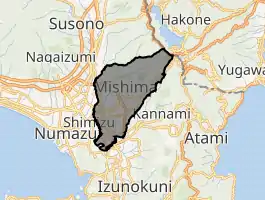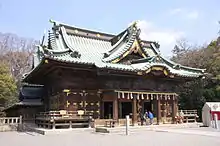Mishima, Shizuoka
Mishima (三島市, Mishima-shi) is a city located in eastern Shizuoka Prefecture, Japan. As of 31 July 2019, the city had an estimated population of 109,803 in 49,323 households,[1] and a population density of 1800 persons per km². The total area of the city is 62.02 square kilometres (23.95 sq mi).
Mishima
三島市 | |
|---|---|
 Mishima Taisha,Mishima Odori Shopping Street,Bamboo light,Genbei River,City center | |
 Flag  Emblem | |

| |
 Location of Mishima in Shizuoka Prefecture | |
 Mishima | |
| Coordinates: 35°07′6.6″N 138°55′6.8″E | |
| Country | Japan |
| Region | Chūbu (Tōkai) |
| Prefecture | Shizuoka |
| First official recorded | 5th century AD |
| City Settled | April 29, 1941 |
| Government | |
| • Mayor | Takeshi Toyooka (since December 2010) |
| Area | |
| • Total | 62.02 km2 (23.95 sq mi) |
| Population (31 July 2019) | |
| • Total | 109,803 |
| • Density | 1,800/km2 (4,600/sq mi) |
| Time zone | UTC+9 (Japan Standard Time) |
| City symbols | |
| • Tree | Ginkgo biloba |
| • Flower | Mishima sakura |
| • Bird | European kingfisher |
| Phone number | 055-975-3111 |
| Address | 4–47 Kitatamachi, Mishima-shi, Shizuoka-ken 411-8666 |
| Website | Official website |



Geography
Mishima is located in far eastern Shizuoka Prefecture, at the northern end of Izu Peninsula and in the foothills of Mount Fuji.
Demographics
Per Japanese census data,[2] the population of Mishima has been increasing over the past 70 years.
| Year | Pop. | ±% |
|---|---|---|
| 1940 | 38,827 | — |
| 1950 | 54,516 | +40.4% |
| 1960 | 62,966 | +15.5% |
| 1970 | 78,141 | +24.1% |
| 1980 | 94,612 | +21.1% |
| 1990 | 105,418 | +11.4% |
| 2000 | 110,519 | +4.8% |
| 2010 | 111,823 | +1.2% |
Climate
Mishima has a humid subtropical climate (Köppen climate classification Cfa) with hot summers and cool winters. Precipitation is significant throughout the year, but is heaviest from June to September. The average annual temperature in Mishima is 14.8 °C. The average annual rainfall is 1939 mm with September as the wettest month. The temperatures are highest on average in August, at around 25.7 °C, and lowest in January, at around 4.8 °C.[3]
| Climate data for Mishima, Shizuoka | |||||||||||||
|---|---|---|---|---|---|---|---|---|---|---|---|---|---|
| Month | Jan | Feb | Mar | Apr | May | Jun | Jul | Aug | Sep | Oct | Nov | Dec | Year |
| Average high °C (°F) | 10.9 (51.6) |
11.2 (52.2) |
14.0 (57.2) |
19.1 (66.4) |
23.1 (73.6) |
25.7 (78.3) |
29.0 (84.2) |
30.9 (87.6) |
27.4 (81.3) |
22.3 (72.1) |
18.0 (64.4) |
13.4 (56.1) |
20.4 (68.8) |
| Daily mean °C (°F) | 5.0 (41.0) |
5.6 (42.1) |
8.6 (47.5) |
13.9 (57.0) |
18.1 (64.6) |
21.5 (70.7) |
25.0 (77.0) |
26.3 (79.3) |
22.9 (73.2) |
17.2 (63.0) |
12.3 (54.1) |
7.3 (45.1) |
15.3 (59.6) |
| Average low °C (°F) | −0.5 (31.1) |
0.4 (32.7) |
3.3 (37.9) |
8.9 (48.0) |
13.2 (55.8) |
17.9 (64.2) |
21.9 (71.4) |
22.7 (72.9) |
19.1 (66.4) |
12.7 (54.9) |
7.2 (45.0) |
1.7 (35.1) |
10.7 (51.3) |
| Average precipitation mm (inches) | 73.9 (2.91) |
87.0 (3.43) |
153.2 (6.03) |
161.6 (6.36) |
165.3 (6.51) |
251.3 (9.89) |
198.1 (7.80) |
221.8 (8.73) |
221.8 (8.73) |
154.0 (6.06) |
110.1 (4.33) |
60.7 (2.39) |
1,858.8 (73.17) |
| Average snowfall cm (inches) | 2 (0.8) |
1 (0.4) |
0 (0) |
0 (0) |
0 (0) |
0 (0) |
0 (0) |
0 (0) |
0 (0) |
0 (0) |
0 (0) |
0 (0) |
3 (1.2) |
| Average relative humidity (%) | 66 | 66 | 67 | 71 | 73 | 78 | 80 | 78 | 78 | 76 | 74 | 70 | 73 |
| Mean monthly sunshine hours | 172.9 | 145.3 | 160.1 | 155.4 | 175.9 | 121.3 | 132.2 | 180.1 | 130.2 | 139.9 | 144.6 | 169.2 | 1,827.1 |
| Source: NOAA (1961–1990) [4] | |||||||||||||
History
Mishima is an ancient town, which developed around the important Shinto shrine of Mishima Shrine (三嶋大社, Mishima Taisha). Under the Ritsuryō administration system established in the Nara period, Mishima was made capital of Izu Province. It was also the location of the Kokubun-ji for Izu Province. In the Edo period, Mishima prospered from its location on the Tōkaidō highway connecting Edo with Kyoto, and Mishima-shuku was one of the 53 post stations on that road. The area was tenryō territory ruled by a daikan appointed directly by the Tokugawa shogunate. After the Meiji Restoration, Mishima became part of the short-lived Nirayama Prefecture in 1868. This merged with the equally short-lived Ashigara Prefecture in 1871, and became part of Shizuoka Prefecture from 18 April 1876. With the establishment of the modern municipalities system of 1889, the area was reorganized as Mishima Town within Kimisawa District. In 1892, Prince Komatsu Akihito established a villa in Mishima. Its gardens, the Rakujūen, are a noted visitor attraction in Mishima to this day. In 1896, Kimisawa District became part of Tagata District, Shizuoka. Mishima received its first train connection in 1898 when the predecessor of the Izuhakone Railway established what is now Shimo-Togari Station. The Sunzu Line began operations from 1906. However, Mishima's fortunes revived strongly only after the Tanna Tunnel was completed in 1934, connecting the town to the Tōkaidō Main Line railway between Tokyo and Shizuoka. Mishima developed rapidly afterwards, merging with neighboring Kitakami Village in 1935 and Watada Village in 1941. Mishima Town was elevated in status to a city on 29 April 1941. It became a stop on the Tōkaidō Shinkansen from 1969, leading to an expansion in population, as the line made it possible to commute to Tokyo.
Government
Mishima has a mayor-council form of government with a directly elected mayor and a unicameral city legislature of 22 members. The city contributes two members to the Shizuoka Prefectural Assembly.
Economy
Mishima is a major industrial center within Shizuoka Prefecture. In addition to a railroad repair facility operated by JR Central, the city hosts factories from:
- Toray
- DMW Corporation
- Toshiba TEC Corporation
- Yokohama Rubber Company
- CFS Corporation (HAC Drugstores)
- Izuhakone Railway Company Ltd
Education
Mishima has 14 public elementary schools, and seven public middle schools operated by the city government and three public high schools operated by the Shizuoka Prefectural Board of Education. There are one private junior high school and two private high schools. In addition, Juntendo University and the Graduate University for Advanced Studies each have a facility at Mishima. The College of International Relations for Nihon University is located in Mishima.
Sister City relations
 Pasadena, California, United States, since 24 July 1957
Pasadena, California, United States, since 24 July 1957 New Plymouth, New Zealand,[5] since 29 April 1991
New Plymouth, New Zealand,[5] since 29 April 1991 Lishui, Zhejiang, China,[5] since 12 May 1997
Lishui, Zhejiang, China,[5] since 12 May 1997
Transport
Railway
.svg.png.webp) Central Japan Railway Company – Tōkaidō Shinkansen
Central Japan Railway Company – Tōkaidō Shinkansen
.svg.png.webp) Central Japan Railway Company – Tōkaidō Main Line
Central Japan Railway Company – Tōkaidō Main Line
- Mishima Station
 Izuhakone Railway – Sunzu Line
Izuhakone Railway – Sunzu Line
- Mishima – Mishima-Hirokōji – Mishima-Tamachi – Mishima-Futsukamachi – Daiba
Highways
.png.webp) Tōmei Expressway
Tōmei Expressway.png.webp) Shin-Tōmei Expressway
Shin-Tōmei Expressway.png.webp) Izu-Jūkan Expressway
Izu-Jūkan Expressway National Route 1
National Route 1 National Route 136
National Route 136
Government facilities
Mishima is home to the National Institute of Genetics.
Local attractions
- Mishima Taisha
- Ryūtaku-ji Rinzai Zen temple
- Izu Kokubun-ji ruins, A National Historic Site
- Yamanaka Castle ruins, A National Historic Site
- Sano Art Museum
- Rakuju-en Gardens
- The Mishima Summer Festival takes place from 15 to 17 August every year
Notable people from Mishima
- EVIL (Real Name: Takaaki Watanabe, Nihongo: 渡辺 高章, Watanabe Takaaki), Japanese professional wrestler
- Sagatsukasa Hiroyuki (Real Name: Hiroyuki Isobe, Nihongo: 磯部 洋之, Isobe Hiroyuki), sumo wrestler
- Makoto Ōoka, poet and literary critic
- Yukiko Sakamoto, Japanese politician
- Nobuyoshi Sano, composer and musician
- Naohiro Takahara, professional soccer player (Okinawa SV, Kyushu Soccer League)
- Yoshiaki Koizumi, videogame designer, director and producer
- Tsutomu Kouno, videogame designer
- Tomomi Takahashi, baseball player (Saitama Seibu Lions, Nippon Professional Baseball – Pacific League)
- Kyohei Uchida, professional soccer player (AC Nagano Parceiro, J3 League)
- Michi Takahashi, teddy bear artist
- Kazuma Suzuki, Japanese stage, film, television actor, film director, fashion designer, and former model
- Mirai Aoshima, Japanese professional shogi player ranked 6-dan and chess master (FIDE Master)
- Shohei Matsunaga, former professional soccer player (attacking midfielder)
- Hikari Takagi, professional soccer player (Nojima Stella Kanagawa Sagamihara, Nadeshiko League and the Japan national football team)
- Hiroshi Takano, Japanese singer, composer, lyricist, music arranger, guitarist and producer
References
- Mishima City official statistics (in Japanese)
- Mishima population statistics
- Mishima climate data
- "Mishima Climate Normals 1961–1990". National Oceanic and Atmospheric Administration. Retrieved 2 January 2012.
- "International Exchange". List of Affiliation Partners within Prefectures. Council of Local Authorities for International Relations (CLAIR). Archived from the original on 13 January 2016. Retrieved 21 November 2015.
External links
| Wikivoyage has a travel guide for Mishima. |
 Media related to Mishima, Shizuoka at Wikimedia Commons
Media related to Mishima, Shizuoka at Wikimedia Commons- Official website (in Japanese)
 Geographic data related to Mishima, Shizuoka at OpenStreetMap
Geographic data related to Mishima, Shizuoka at OpenStreetMap